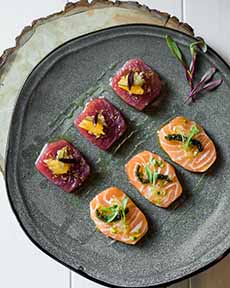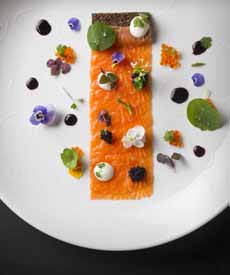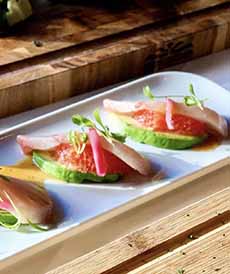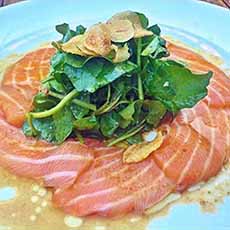|

[1] Tuna and salmon crudo, simply garnished (photo © Elea | NYC).

[2] Like a painting: salmon crudo from Mihoko’s 21 Grams | NYC.

[3] Creative plating: avocado, pink grapefruit, hamachi and garnish of microgreen and radish (photo © Fleming’s Prime Steakhouse| NYC).

[4] Add some salad on the side or on top (photo © Catch | NYC).
|
|
Looking for low-calorie deliciousness? Or an easy-to-make, sophisticated first course?
We nominate crudo. It’s raw fish, kin to sashimi, but with a different cut and very varied garnishes.
It’s the fish version of carpaccio, made from beef (although chefs have adopted the term for vegetable and other meat carpaccios). A recipe is .
TYPES OF RAW FISH DISHES
Crudo is the term for raw fish or seafood. You will find fish “crudo” on restaurant menus, but that doesn’t make it correct. Raw fish consumption is an ancient practice, beginning with fisherman who would fillet their catch while out on the boat and season it with a bit of salt.
Ceviche, seviche or sebiche, from South America, is a marinated raw fish dish that date to pre-Colombian times. Then, seafood was “cooked” (acid-cured) with a fruit called tumbo (Passiflora tarminina, a relative of passionfruit). The Incas cured fish in salt and fermented corn. The Spanish brought onions limes, which are essential to today’s ceviche.
Crudo is analogous to sashimi—plain raw fish, although the fish is cut differently.
Poke is a Hawaiian dish that recently has made its way from coast to coast. A mix of raw fish and vegetables are served as an appetizer or salad course. It is different from tiradito or ceviche in that the fish is cubed with a soy sauce and sesame oil dressing, and Hawaiian garnishes like roasted crushed candlenut and limu seaweed, along with chopped chiles. It is pronounced poe-KEH. Here’s more about it.
Sashimi is Japanese-style sliced raw fish, generally served with a bowl of plain, steamed rice (not sushi rice, which is prepared with vinegar and sugar). The word literally means “pierced body.” No one is certain of the origin, but it may have come from the former practice of sticking the tail and fin of the fish on the slices, to let it be known which fish one was eating.
Tataki is a fillet of fish that is lightly seared; just the surface is cooked, with the majority of the fish eaten in its raw state.
Tiradito is a more recent dish, fusing the concepts of ceviche and sashimi. Fish is sliced in pieces that are longer and thinner than sashimi. They are artfully arranged on a plate on top of a light sauce, and garnished (with cilantro, fresh corn kernels, thin slices of hot chile, etc.). The name derives from the Spanish verb tirar, which means to throw (i.e., throwing together raw fish with a sauce). Here’s a recipe.
RECIPE: CRUDO OF TUNA & SALMON
Tailor this recipe to your preferences. For example, you can replace the conventional olive oil drizzle with flavored olive oil, add balsamic vinegar, use a Dijon vinaigrette, etc. Garnish with arugula, citrus, herbs, mango, mesclun salad, microgreens, salmon caviar, watercress, etc.
For a larger dish, you can add salad on top or on the side, dressed very lightly. We like a lemon vinaigrette—half vinegar, half lemon [or lime] juice), or just a flavored olive oil, before topping the fish.
Ingredients For 4 Servings
1 pound sushi-grade fish loin or steaks, sliced as desired
Quality extra-virgin olive oil
Sea salt, plus peppermill
Minced chives
2 cups baby greens, loosely packed: arugula, watercress or mesclun mix (more as desired)
Vinaigrette as desired
Garnishes: capers, microgreens, thinly-sliced hot chile and lemon wedges, etc.
Preparation
1. Combine vinegar and mustard in small bowl; whisk in 4 tablespoons olive oil. Season dressing to taste with sea salt and pepper. DO AHEAD: Can be made 1 day ahead. Cover; chill.
|
2. Place a sheet of plastic wrap on a damp work surface (the moisture prevents the plastic from slipping).
Arrange the tuna slices on the plastic as you would like them to be on the plate (this makes plating them easy). Cover with a second sheet of plastic wrap.
3. USING the flat side of a mallet, gently pound the fish slices until they are to your desired thinness. Do this in batches as necessary.
Refrigerate the fish in the plastic for at least 30 minutes, and up to 4 hours.
3. ASSEMBLE: Remove the top plastic sheet from each serving of fish and place a plate upside-down on top of the fish.
Invert the fish onto the plate and peel off the remaining plastic. Drizzle with olive oil, then sprinkle with a bit of sea salt, chives and pepper.
Toss watercress and 2 tablespoons dressing in medium bowl; season to taste with sea salt and pepper.
4. MOUND the salad greens on top and serve.
|



